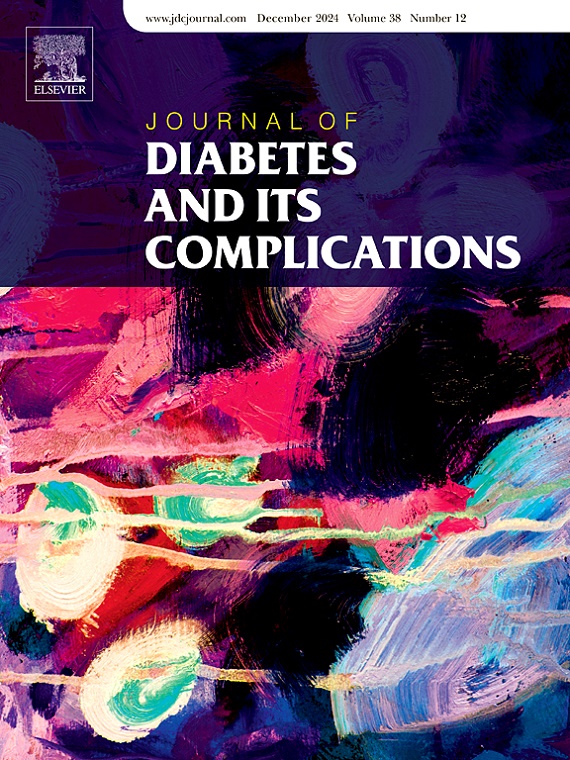High rate of complications in a real-world cohort of youth with T2D: a multicenter analysis
IF 3.1
3区 医学
Q3 ENDOCRINOLOGY & METABOLISM
引用次数: 0
Abstract
Introduction
The TODAY2 study reported that 80 % of young adults with youth-onset T2D (YoT2D) had at least one diabetes comorbidity or complication at a mean duration of 13 years. Prevalence rates of comorbidities and microvascular complications in YoT2D with shorter duration and younger age is unclear, particularly in the age of new pharmacotherapies.
Methods
In a multicenter retrospective analysis, presence of comorbidities (hypertension (systolic BP > 130 or diastolic BP > 80), dyslipidemia (LDL > 130 mg/dL or triglycerides>150 mg/dL), elevated liver enzymes (AST > 25 U/L, or ALT U/L > 22 for females or >26 U/L for males)) and microvascular complications (microalbuminuria (microalbumin/creatinine ratio > 30), diabetic retinopathy) in patients with YoT2D at three academic pediatric diabetes centers were assessed. Ordinal logistic regression models assessed the associations between demographic and clinical variables and increased odds of either comorbidities or complications.
Results
The study included 298 youth (median age 16.6 years, 60 % female, 57 % Black, 14 % Hispanic). The median duration of T2D was 1.8 years, median HbA1c was 6.9 % (42 % had an HbA1c < 6.5 %). Over 80 % of patients had at least 1 comorbidity, 29 % with hypertension, 49 % with dyslipidemia, and 56 % with elevated liver enzymes. In the cohort, 21 % had at least 1 microvascular complication, 17 % with microalbuminuria, and 4.6 % with diabetic retinopathy. Proportion using GLP-1 receptor agonists and SGLT-2 inhibitors were 36 % and 7 %, respectively. Higher HbA1c and BMI increased the odds of having an additional comorbidity or complication, and longer diabetes duration increased the odds of having microvascular complications.
Conclusions
This study found comorbidities and microvascular complications in YoT2D at younger ages and short duration of diabetes despite use of new medications. Efforts are needed to improve glycemic control and other risk factors to reduce diabetes-related complications in YoT2D.
青少年T2D患者的高并发症发生率:一项多中心分析
TODAY2研究报告称,80%的青年T2D (YoT2D)患者在平均持续时间13年期间至少有一种糖尿病合并症或并发症。持续时间较短、年龄较小的YoT2D患者的合并症和微血管并发症患病率尚不清楚,特别是在新药物治疗时代。方法采用多中心回顾性分析方法,对合并高血压(收缩压和血压;130或舒张压;80),血脂异常(LDL >;130毫克/分升或甘油三酯150毫克/分升),肝酶升高(AST;25u /L,或ALT U/L >;(女性22 U/L,男性26 U/L))和微血管并发症(微量白蛋白/肌酐比值>;30),糖尿病视网膜病变)的YoT2D患者在三个学术儿科糖尿病中心进行评估。有序逻辑回归模型评估了人口学和临床变量之间的关系,以及合并症或并发症的增加几率。结果该研究包括298名青少年(中位年龄16.6岁,60%为女性,57%为黑人,14%为西班牙裔)。T2D的中位持续时间为1.8年,中位HbA1c为6.9%(42%的患者有HbA1c和lt;6.5%)。超过80%的患者至少有一种合并症,29%患有高血压,49%患有血脂异常,56%患有肝酶升高。在队列中,21%有至少一种微血管并发症,17%有微量白蛋白尿,4.6%有糖尿病视网膜病变。使用GLP-1受体激动剂和SGLT-2抑制剂的比例分别为36%和7%。较高的HbA1c和BMI增加了其他合并症或并发症的几率,较长的糖尿病病程增加了微血管并发症的几率。结论本研究发现,尽管使用了新药物,但年龄较小且病程较短的YoT2D患者仍存在合并症和微血管并发症。需要努力改善血糖控制和其他危险因素,以减少YoT2D的糖尿病相关并发症。
本文章由计算机程序翻译,如有差异,请以英文原文为准。
求助全文
约1分钟内获得全文
求助全文
来源期刊

Journal of diabetes and its complications
医学-内分泌学与代谢
CiteScore
5.90
自引率
3.30%
发文量
153
审稿时长
16 days
期刊介绍:
Journal of Diabetes and Its Complications (JDC) is a journal for health care practitioners and researchers, that publishes original research about the pathogenesis, diagnosis and management of diabetes mellitus and its complications. JDC also publishes articles on physiological and molecular aspects of glucose homeostasis.
The primary purpose of JDC is to act as a source of information usable by diabetes practitioners and researchers to increase their knowledge about mechanisms of diabetes and complications development, and promote better management of people with diabetes who are at risk for those complications.
Manuscripts submitted to JDC can report any aspect of basic, translational or clinical research as well as epidemiology. Topics can range broadly from early prediabetes to late-stage complicated diabetes. Topics relevant to basic/translational reports include pancreatic islet dysfunction and insulin resistance, altered adipose tissue function in diabetes, altered neuronal control of glucose homeostasis and mechanisms of drug action. Topics relevant to diabetic complications include diabetic retinopathy, neuropathy and nephropathy; peripheral vascular disease and coronary heart disease; gastrointestinal disorders, renal failure and impotence; and hypertension and hyperlipidemia.
 求助内容:
求助内容: 应助结果提醒方式:
应助结果提醒方式:


